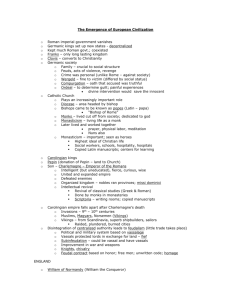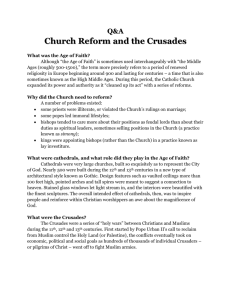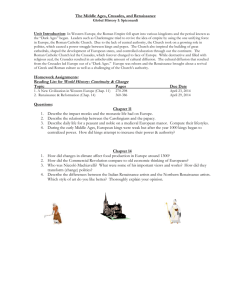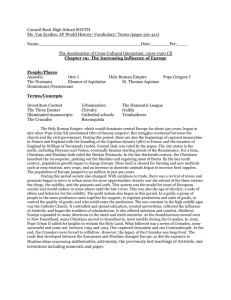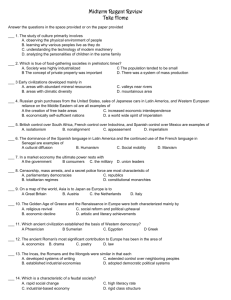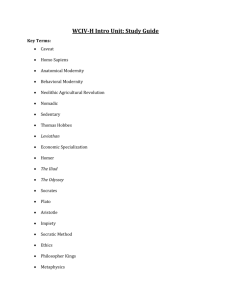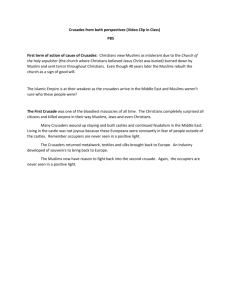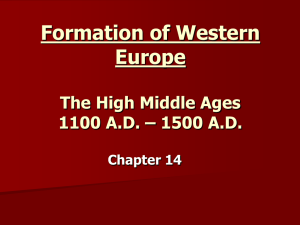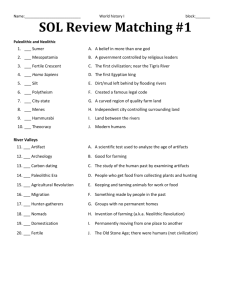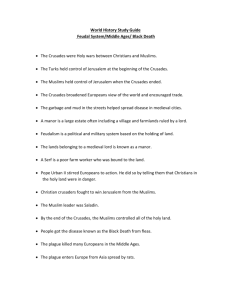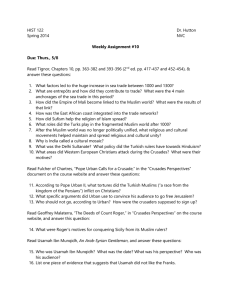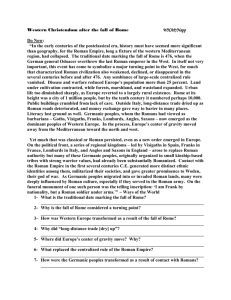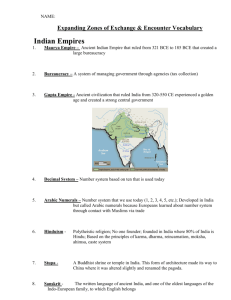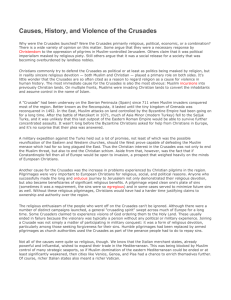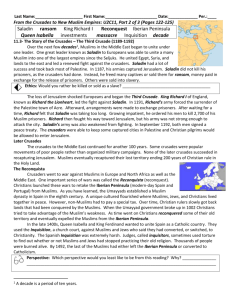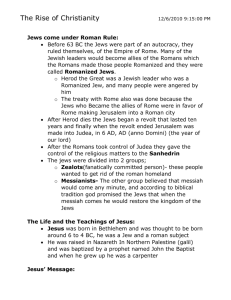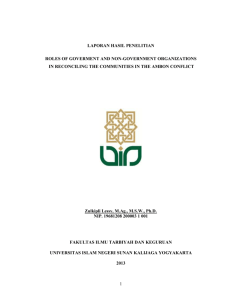Study Guide for Second Semester Exam, June, 2010
advertisement
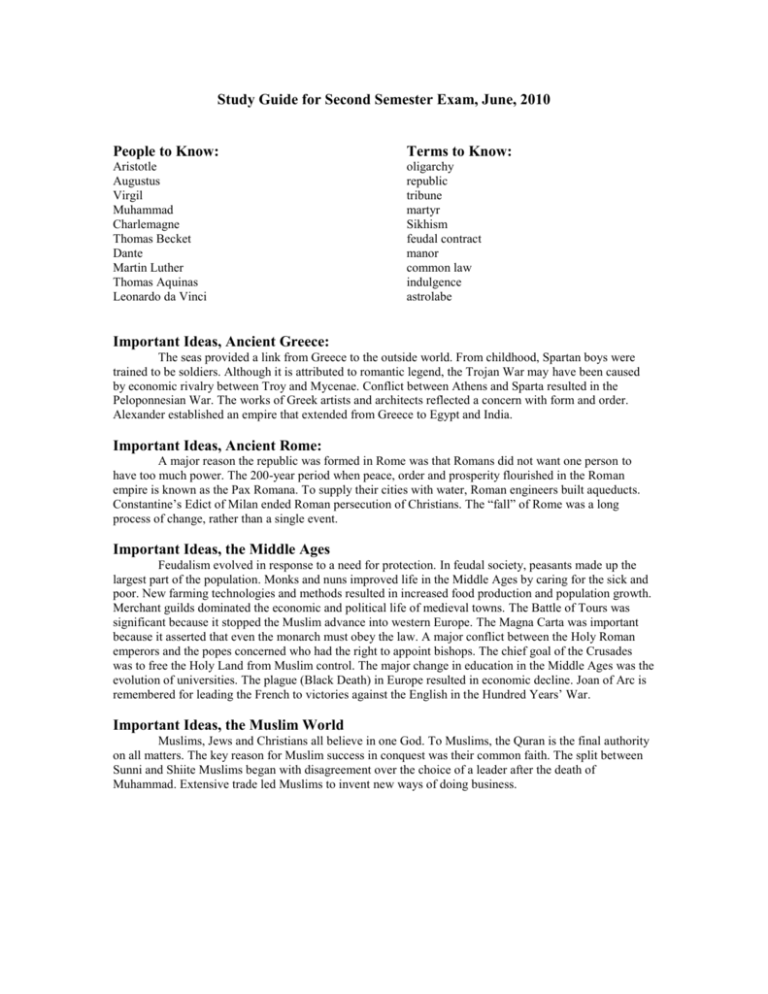
Study Guide for Second Semester Exam, June, 2010 People to Know: Terms to Know: Aristotle Augustus Virgil Muhammad Charlemagne Thomas Becket Dante Martin Luther Thomas Aquinas Leonardo da Vinci oligarchy republic tribune martyr Sikhism feudal contract manor common law indulgence astrolabe Important Ideas, Ancient Greece: The seas provided a link from Greece to the outside world. From childhood, Spartan boys were trained to be soldiers. Although it is attributed to romantic legend, the Trojan War may have been caused by economic rivalry between Troy and Mycenae. Conflict between Athens and Sparta resulted in the Peloponnesian War. The works of Greek artists and architects reflected a concern with form and order. Alexander established an empire that extended from Greece to Egypt and India. Important Ideas, Ancient Rome: A major reason the republic was formed in Rome was that Romans did not want one person to have too much power. The 200-year period when peace, order and prosperity flourished in the Roman empire is known as the Pax Romana. To supply their cities with water, Roman engineers built aqueducts. Constantine’s Edict of Milan ended Roman persecution of Christians. The “fall” of Rome was a long process of change, rather than a single event. Important Ideas, the Middle Ages Feudalism evolved in response to a need for protection. In feudal society, peasants made up the largest part of the population. Monks and nuns improved life in the Middle Ages by caring for the sick and poor. New farming technologies and methods resulted in increased food production and population growth. Merchant guilds dominated the economic and political life of medieval towns. The Battle of Tours was significant because it stopped the Muslim advance into western Europe. The Magna Carta was important because it asserted that even the monarch must obey the law. A major conflict between the Holy Roman emperors and the popes concerned who had the right to appoint bishops. The chief goal of the Crusades was to free the Holy Land from Muslim control. The major change in education in the Middle Ages was the evolution of universities. The plague (Black Death) in Europe resulted in economic decline. Joan of Arc is remembered for leading the French to victories against the English in the Hundred Years’ War. Important Ideas, the Muslim World Muslims, Jews and Christians all believe in one God. To Muslims, the Quran is the final authority on all matters. The key reason for Muslim success in conquest was their common faith. The split between Sunni and Shiite Muslims began with disagreement over the choice of a leader after the death of Muhammad. Extensive trade led Muslims to invent new ways of doing business. Important Ideas, the Renaissance Artists of the Renaissance focused on human beings and their experiences. The invention of the printing press made it possible for more people to learn to read and write. The Roman Catholic Church reacted to Martin Luther’s ideas by excommunicating him. As a result of the Catholic Reformation, new schools were founded to train the clergy. The new scientific method that developed during the Renaissance was based on observation and experimentation. Descartes believed people could discover basic truths through reason. Important Ideas, the First Global Age: Europe and Asia Vasco da Gama was the first explorer to reach India by sailing around Africa. Southeast Asia is composed of a mainland and scattered islands. The Portuguese gained control of trade in Southeast Asia through the use of military force. In the 1600s, the Portuguese lost control of trade in the Indian Ocean to the Dutch. In the 1500s the Chinese were not interested in trading with Europeans because they thought European goods were inferior to Chinese goods. Because of wars with Japan and the Manchus, Korea adopted a policy of isolationism. Places to locate on a map: Athens Crete Land of the Gauls Rome Sparta Avignon England Messina, Sicily Paris Spain Essay Questions (you will need to answer two): 1. Compare the Romanesque style of architecture with the Gothic style I. Romanesque A. Low buildings B. Thick walls C. Tiny window slits D. Heavy, barrel-vaulted roofs E. Towers F. Dark, gloomy interiors II. Gothic A. Tall and graceful B. Thinner walls, supported by flying buttresses C. Lofty ceilings D. Large stained-glass windows depicting religious scenes E. Tall spires F. Interior light that symbolized God’s presence 2. Identify and explain 3 long-term effects of the crusades I. Economic expansion A. Increased trade—new products, ships to carry goods B. Growth in use of money C. Undermined serfdom II. Increased power for monarchs A. Rights to collect taxes B. Some led crusades, increasing their prestige III. Increased power for popes A. Papal power grew to greatest height B. Power increase did not last long, due to conflicts with feudal monarchs C. Crusades hardened Byzantine resentment toward the West IV. Wider worldview A. European Christians realized many people lived in faraway places they didn’t know about B. Some curious Europeans, like Marco Polo, traveled to distant lands 3. Forces that united the Greeks, despite divisions caused by geography and economic rivalry A. Language B. Heroes C. Religion D. Common enemy (Persians) 4. How Roman law protected the rights of the accused A. Presumed innocent B. Allowed to face accuser C. Allowed to defend against the charge D. Guilt established through evidence E. Judges allowed to interpret laws and expected to make fair decisions
